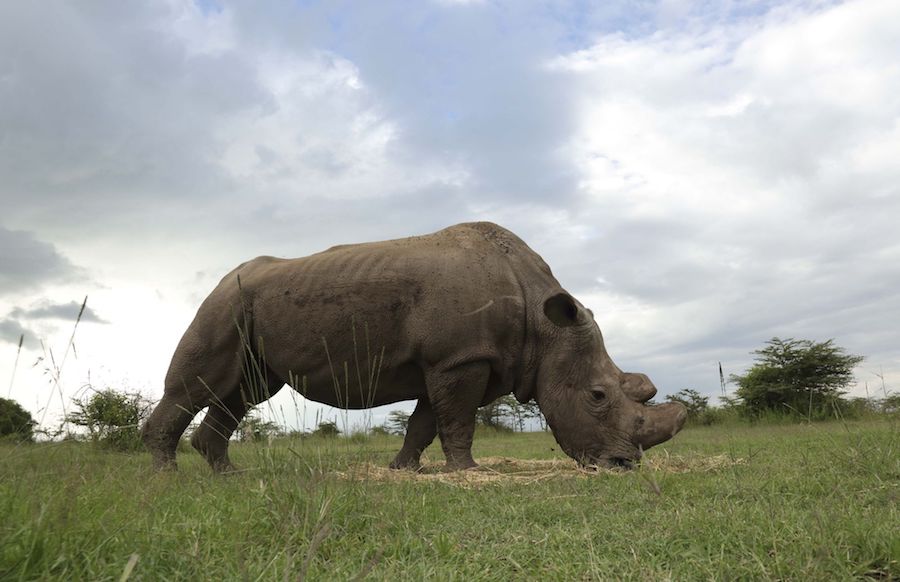5 species whose survival could benefit from tourism
Animals on the brink of extinction
As we wave goodbye to the world’s last male northern white rhino, Sarah Marshall looks at more species we can’t risk losing.
The death of any celebrity evokes a sense of shared sadness, even if the A-lister in question belongs to the animal kingdom. But the story of Sudan, the northern white rhino who passed away on March 19, is especially heart-breaking.
Being the last surviving male of a subspecies decimated by poaching and habitat destruction, his death signifies yet another needless wildlife loss.
I, for one, cried when I heard the news. Not because I knew him personally, but as an expression of frustration. Every day, we lose a little bit more of our beautiful planet, and we’re the only ones to blame.
Sudan’s story highlights even bigger issues in the natural world, where species – from insects through to mammals – are increasingly threatened by human activity. As David Attenborough has stressed time and time again, we are in the midst of a mass extinction. This is happening around us. Right now.
Is there any hope for the future?

The world’s only male northern white rhino, Sudan, has died aged 45
Although two female northern white rhinos, Najin and Fatu, remain, the only hopes for continuing their line lie in IVF treatments using stored semen from Sudan. (Four years ago, vets realised he would be unable to mate naturally.)
What can we do?
Born in the wild, Sudan grew up in zoos and lived the last few years of his life in Kenya’s Ol Pejeta conservancy, captivating tourists who came to learn about his plight and contribute funds to the IVF scheme.
Managed and properly controlled, tourism can be used as an effective tool to protect species and raise awareness about the natural world.
All the animals below appear in the International Union For Conservation Of Nature Red List – the official barometer for endangered species. By visiting them now and making an economic contribution, you could be safeguarding their future.
1. Orangutans in Borneo

Orangutans at the Sarawak Semenggoh Wildlife Rehabilitation Centre in Kuching
Classified as Critically Endangered on the IUCN list, which is one step away from extinction, these primates can only be found in two places – Sumatra, in Indonesia, and the island of Borneo. The main reason for their decline? Deforestation in favour of palm oil plantations. It’s often tricky to see them in the wild, but sightings are guaranteed at the Sepilok Rehabilitation Centre in Sabah and Semenggoh Wildlife Rehabilitation Centre in Sarawak – both in Borneo.
How: G Adventures (gadventures.co.uk) offers a 14-day escorted Experience Borneo trip as part of their Jane Goodall collection. A portion of funds from the £1,699pp land-only price are donated to her institute, which helps to protect primates worldwide.
2. Pangolins in Namibia
Looking like creatures from a prehistoric era, these small, scaly anteaters are the most trafficked animal in the world. Their scales are dried and sold as medicine and have even been used to make coats. Having evolved over 80 million years, they can be found in parts of Asia and Africa, although being nocturnal, they are hard to spot. One ‘relatively’ reliable place to enjoy encounters is Okonjima Nature Reserve in Namibia; Chris Packham saw his first pangolin here and so did I.
How: Expert Africa (expertafrica.com) offers an 11-day tailor-made Impala Self-drive Safari from £1,241pp (land-only), including a stay at Okonjima, where the AfriCat Foundation supports wildlife conservation.
3. Tigers in India

Tiger relaxing in Tadoba National Park
The biggest cat on our planet is also the most under threat – once again the victim of a futile medicine market. The Bengal tiger is the most iconic of the species and can be found in parks across India. Tadoba Andhari Tiger Reserve in Maharashtra state is a more under-the-radar option, where the emphasis on conservation is still greater than tourism.
How: Steppes Travel (steppestravel.com) has a 14-day tailor-made Tiger Safari to Tadoba, Pench and Kanha from £3,345pp (excluding flights). Along with searching for tigers, the trip includes a focus on conservation efforts in the parks.
4. Mountain Gorillas in Uganda

Gorilla infant in Bwindi Impenetrable Forest
Spread across Uganda, Rwanda and the Congo, mountain gorillas have suffered at the hands of poachers and civil warfare. A new census, about to take place, promises to show an increase in numbers – although the great apes are not out of the danger zone just yet. With cheaper permit prices and rated as one of the most stable countries in Africa, Uganda is the best place to go.
How: A percentage of the US$600 (£430) one-hour permit price goes to community projects and conservation. Keep costs low by arranging your own trip and staying at the excellent Ride 4 A Woman ( ride4awoman.org) community hostel in Bwindi, where doubles cost from US$130/£93 full board.
5. Ethiopian wolves in Ethiopia

Ethiopian wolf at sunset on the Sanetti Plateau
Almost wiped out by cases of canine distemper, spread by domestic dogs, the world’s rarest canid struggles to survive in Ethiopia’s Simien Mountains and the Sanetti Plateau. The latter area is part of the Bale Mountains, where British couple Yvonne and Guy Levene run the Bale Mountain Lodge with conservation always in mind.
How: Doubles at the Bale Mountain Lodge (balemountainlodge.com) cost from US$190/£135 all-inclusive.
The Press Association
Latest posts by The Press Association (see all)
- 5 surprising things you can clean in the washing machine - January 9, 2025
- Prince William posted a heartfelt birthday message to ‘most incredible wife and mother’ - January 9, 2025
- Birthday wishes for Catherine from royal family as the Princess of Wales turns 43 - January 9, 2025
- Maple Cinnamon Granola - January 8, 2025
- 8 things your feet can tell you about your health - January 8, 2025





















